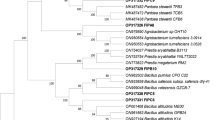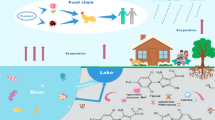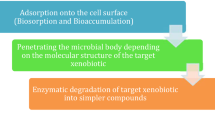Abstract
Fipronil is a highly active, broad spectrum insecticide with increasing and wide use. The degradation of fipronil was studied in Brazilian soil under oxic and anoxic conditions. Under oxic conditions, the half-life of fipronil was 16.9 days, with fipronil sulfone as the main metabolite, and no further degradation during 30 days of incubation. This degradation was accompanied by an increase of bacterial and archaeal ammonia oxidizers, as well as denitrifiers, and microorganisms related to Sphingomonas. Under anoxic conditions, a half-life of 15.7 days for fipronil was obtained, with fipronil sulphide as the primary metabolite, and fipronil sulfone at lower concentrations, with no further degradation of these metabolites during 90 days of incubation. In these conditions, complete degradation of fipronil was accompanied by an increase of denitrifiers, iron-reducers and ammonia oxidizers and selection of microorganisms that are related to uncultured Clostridiales (family VIII). Sulphate reducers and methanogens and most of the microbial community were not affected by fipronil and its metabolites. Toxicity evaluation, using in vitro effect-based CALUX assays confirmed that the metabolites have a similar toxic potency as compared to the parent compound fipronil. Therefore, the potential (eco)toxicity of fipronil does not seem to decrease upon microbial degradation.




Similar content being viewed by others
References
Abraham, J., & Gajendiran, A. (2019). Biodegradation of fipronil and its metabolite fipronil sulfone by Streptomyces rochei strain AJAG7 and its use in bioremediation of contaminated soil. Pesticide Biochemistry and Physiology, 155, 90–100. https://doi.org/10.1016/j.pestbp.2019.01.011.
Adkins, A. (1999). Degradation of the phenoxy acid herbicide diclofop-methyl by Sphingomonas paucimobilis isolated from a Canadian prairie soil. Journal of Industrial Microbiology & Biotechnology, 23, 332–335. https://doi.org/10.1038/sj.jim.2900744.
Ait-Aissa, S., Laskowski, S., Laville, N., Porcher, J. M., & Brion, F. (2010). Anti-androgenic activities of environmental pesticides in the MDA-kb2 reporter cell line. Toxicology In Vitro, 24, 1979–1985.
Alvarez, A., Saez, J. M., Davila Costa, J. S., Colin, V. L., Fuentes, M. S., Cuozzo, S. A., Benimeli, C. S., Polti, M. A., & Amoroso, M. J. (2017). Actinobacteria: Current research and perspectives for bioremediation of pesticides and heavy metals. Chemosphere, 166, 41–62.
Bastida, F., Nicolás, C., Moreno, J. L., Hernández, T., & García, C. (2010). Tracing changes in the microbial community of a hydrocarbon-polluted soil by culture-dependent proteomics. Pedosphere, 20, 479–485. https://doi.org/10.1016/S1002-0160(10)60037-9.
Bonmatin, J. M., Giorio, C., Girolami, V., Goulson, D., Kreutzweiser, D. P., Krupke, C., Liess, M., Long, E., Marzaro, M., Mitchell, E. A., Noome, D. A., Simon-Delso, N., & Tapparo, A. (2015). Environmental fate and exposure; neonicotinoids and fipronil. Environmental Science and Pollution Research, 22, 35–67. https://doi.org/10.1007/s11356-014-3332-7.
Bordonal, R.d. O., Carvalho, J. L. N., Lal, R., Figueiredo, E. B., Oliveira, B. G., & La Scala Jr., N. (2018). Sustainability of sugarcane production in Brazil. A review. Agronomy for Sustainable Development, 38, 1–23. https://doi.org/10.1007/s13593-018-0490-x.
Brennan, A. A., Harwood, A. D., You, J., Landrum, P. F., & Lydy, M. J. (2009). Degradation of fipronil in anaerobic sediments and the effect on porewater concentrations. Chemosphere, 77, 22–28. https://doi.org/10.1016/j.chemosphere.2009.06.019.
Cappelini, L. T. D., Alberice, J. V., Eugênio, P. F. M., Pozzi, E., Urbaczek, A. C., Diniz, L. G. R., Carrilho, E. N. V. M., Carrilho, E., & Vieira, E. M. (2018). Burkholderia thailandensis: The main bacteria biodegrading fipronil in fertilized soil with assessment by a QuEChERS/GC-MS Method. Journal of the Brazilian Chemical Society, 29, 1934–1943. https://doi.org/10.21577/0103-5053.20180069.
Cavaletti, L., Monciardini, P., Bamonte, R., Schumann, P., Ronde, M., Sosio, M., & Donadio, S. (2006). New lineage of filamentous, spore-forming, gram-positive bacteria from soil. Applied and Environmental Microbiology, 72, 4360–4369. https://doi.org/10.1128/AEM.00132-06.
Chien, C., Kuo, Y., Chen, C., Hung, C., Yeh, C., & Yeh, W. (2008). Microbial diversity of soil bacteria in agricultural field contaminated with heavy metals. Journal of Environmental Sciences, 20, 359–363. https://doi.org/10.1016/S1001-0742(08)60056-X.
Cox, M. P., Peterson, D. A., & Biggs, P. J. (2010). SolexaQA: At-a-glance quality assessment of Illumina second-generation sequencing data. BMC Bioinformatics, 11, 485. https://doi.org/10.1186/1471-2105-11-485.
Delgado-Baquerizo, M., Oliverio, A. M., Brewer, T. E., Benavent-González, A., Eldridge, D. J., Bardgett, R. D., Maestre, F. T., Singh, B. K., & Fierer, N. (2018). A global atlas of the dominant bacteria found in soil. Science, 359, 320–325. https://doi.org/10.1126/science.aap9516.
Dhillon, A., Teske, A., Dillon, J., Stahl, D. A., & Sogin, M. L. (2003). Molecular characterization of sulfate-reducing bacteria in the Guaymas basin. Applied and Environmental Microbiology, 69, 2765–2772. https://doi.org/10.1128/AEM.69.5.2765-2772.2003.
Doran, G., Eberbach, P., & Helliwell, S. (2009). Sorption and degradation of fipronil in flooded anaerobic rice soils. Journal of Agricultural and Food Chemistry, 57, 10296–10301. https://doi.org/10.1021/jf902644x.
Ederer, M. M., Lewis, T. A., & Crawford, R. L. (1997). 2,4,6-Trinitrotoluene (TNT) transformation by clostridia isolated from a munition-fed bioreactor: comparison with non-adapted bacteria. Journal of Industrial Microbiology & Biotechnology, 18, 82–88. https://doi.org/10.1038/sj.jim.2900257.
Edgar, R. C., Haas, B. J., Clemente, J. C., Quince, C., & Knight, R. (2011). UCHIME improves sensitivity and speed of chimera detection. Bioinformatics, 27, 2194–2200. https://doi.org/10.1093/bioinformatics/btr381.
Francis, C. A., Roberts, K. J., Beman, J. M., Santoro, A. E., & Oakley, B. B. (2005). Ubiquity and diversity of ammonia-oxidizing archaea in water columns and sediments of the ocean. Proceedings of the National Academy of Sciences of the United States of America, 102, 14683–14688. https://doi.org/10.1073/pnas.0506625102.
Fuess, L. T., Rodrigues, I. J., & Garcia, M. L. (2017). Fertirrigation with sugarcane vinasse: Foreseeing potential impacts on soil and water resources through vinasse characterization. Journal of Environmental Science and Health Part A, 52(11), 1063–1072. https://doi.org/10.1080/10934529.2017.1338892.
Fuess, L. T., Garcia, M. L., & Zaiat, M. (2018). Seasonal characterization of sugarcane vinasse: assessing environmental impacts from fertirrigation and the bioenergy recovery potential through biodigestion. Science of the Total Environment, 634, 29–40. https://doi.org/10.1016/j.scitotenv.2018.03.326.
Gunasekara, A. S., Truong, T., Goh, K. S., Spurlock, F., & Tjeerdema, R. S. (2007). Environmental fate and toxicology of fipronil. Journal of Pesticide Science, 32, 189–199. https://doi.org/10.1584/jpestics.R07-02.
Hales, B. A., Edwards, C., Ritchie, D. A., Hall, G., Pickup, R. W., & Saunders, J. R. (1996). Isolation and identification of methanogen-specific DNA from blanket bog peat by PCR amplification and sequence analysis. Applied and Environmental Microbiology, 62, 668–675. https://doi.org/10.1128/aem.62.2.668-675.1996.
Hammill, T. B., & Crawford, R. L. (1996). Degradation of 2-sec-butyl-4,6-dinitrophenol (dinoseb) by Clostridium bifermentans KMR-1. Applied and Environmental Microbiology, 62, 1842–1846.
Henry, S., Baudoin, E., López-Gutiérrez, J. C., Martin-Laurent, F., Brauman, A., & Philippot, L. (2004). Quantification of denitrifying bacteria in soils by nirK gene targeted real-time PCR. Journal of Microbiological Methods, 59, 327–335. https://doi.org/10.1016/j.mimet.2004.07.002.
Holmes, D. E., Finneran, K. T., O’Neil, R. A., & Lovley, D. R. (2002). Enrichment of members of the family Geobacteraceae associated with stimulation of dissimilatory metal reduction in uranium-contaminated aquifer sediments. Applied and Environmental Microbiology, 68, 2300–2306. https://doi.org/10.1128/AEM.68.5.2300-2306.2002.
Kaur, G., Sharma, R., Singh, K., & Sharma, P. K. (2015). Delineating bacterial community structure of polluted soil samples collected from cancer prone belt of Punjab, India. 3 Biotech, 5, 727–734. https://doi.org/10.1007/s13205-014-0270-5.
Klindworth, A., Pruesse, E., Schweer, T., Peplies, J., Quast, C., Horn, M., & Glöckner, F. O. (2013). Evaluation of general 16S ribosomal RNA gene PCR primers for classical and next-generation sequencing-based diversity studies. Nucleic Acids Research, 41, e1. https://doi.org/10.1093/nar/gks808.
Kumar, R., Singh, B., & Gupta, V. K. (2012). Biodegradation of fipronil by Paracoccus sp. in different types of soil. Bulletin of Environmental Contamination and Toxicology, 88, 781–787. https://doi.org/10.1007/s00128-012-0578-y.
Lane, D. (1991). 16S/23S sequencing. In E. Stackebrandt & M. Goodfellow (Eds.), Nucleic acids techniques in bacterial systematics (pp. 205–248). Chichester: Wiley.
Lemaire, G., Mnif, W., Pascussi, J. M., Pillon, A., Rabenoelina, F., Fenet, H., Gomez, E., Casellas, C., Nicolas, J. C., Cavailles, V., Duchesne, M. J., & Balaguer, P. (2006). Identification of new human pregnane X receptor ligands among pesticides using a stable reporter cell system. Toxicological Sciences, 91, 501–509.
Lewis, T. A., Ederer, M. M., Crawford, R. L., & Crawford, D. L. (1997). Microbial transformation of 2,4,6-trinitrotoluene. Journal of Industrial Microbiology & Biotechnology, 18, 89–96.
Mahé, F., Rognes, T., Quince, C., de Vargas, C., & Dunthorn, M. (2014). Swarm: Robust and fast clustering method for amplicon-based studies. PeerJ, 2014, e593. https://doi.org/10.7717/peerj.593.
Martins, J. M., & Mermoud, A. (1998). Sorption and degradation of four nitroaromatic herbicides in mono and multi-solute saturated/unsaturated soil batch systems. Journal of Contaminant Hydrology, 33, 187–210. https://doi.org/10.1016/S0169-7722(98)00070-9.
Masella, A. P., Bartram, A. K., Truszkowski, J. M., Brown, D. G., & Neufeld, J. D. (2012). PANDAseq: Paired-end assembler for illumina sequences. BMC Bioinformatics, 13, 31. https://doi.org/10.1186/1471-2105-13-31.
Masutti, C. S. M., & Mermut, A. R. (2007). Degradation of fipronil under laboratory conditions in a tropical soil from Sirinhaém Pernambuco. Journal of Environmental Science and Health Part B, 42, 33–43. https://doi.org/10.1080/03601230601017981.
Mossa, A. H., Swelam, E. S., & Mohafrash, S. S. M. (2015). Sub-chronic exposure to fipronil induced oxidative stress, biochemical and histopathological changes in the liver and kidney of male albino rats. Toxicology Reports, 2, 775–784.
Muyzer, G., & Ramsing, N. B. (1995). Molecular methods to study the organization of microbial communities. Water Science and Technology, 32, 1–9. https://doi.org/10.1016/0273-1223(96)00001-7.
Mysara, M., Saeys, Y., Leys, N., Raes, J., & Monsieurs, P. (2015). CATCh, an ensemble classifier for chimera detection in 16s rRNA sequencing studies. Applied and Environmental Microbiology, 81, 1573–1584. https://doi.org/10.1128/AEM.02896-14.
Ohi, M., Dalsenter, P. R., Andrade, A. J., & Nascimento, A. J. (2004). Reproductive adverse effects of fipronil in Wistar rats. Toxicology Letters, 146, 121–127.
Okano, Y., Hristova, K. R., Leutenegger, C. M., Jackson, L. E., Denison, R. F., Gebreyesus, B., Lebauer, D., & Scow, K. M. (2004). Application of real-time PCR to study effects of ammonium on population size of ammonia-oxidizing bacteria in soil. Applied and Environmental Microbiology, 70, 1008–1016. https://doi.org/10.1128/AEM.70.2.1008-1016.2004.
Pisa, L. W., Amaral-Rogers, V., Belzunces, L. P., Bonmatin, J. M., Downs, C. A., Goulson, D., Kreutzweiser, D. P., Krupke, C., Liess, M., Mcfield, M., Morrissey, C. A., Noome, D. A., Settele, J., Simon-Delso, N., Stark, J. D., Van Der Sluijs, J. P., Van Dyck, H., & Wiemers, M. (2014). Effects of neonicotinoids and fipronil on non-target invertebrates. Environmental Science and Pollution Research, 22, 68–102. https://doi.org/10.1007/s11356-014-3471-x.
Quast, C., Pruesse, E., Yilmaz, P., Gerken, J., Schweer, T., Yarza, P., Peplies, J., & Glöckner, F. O. (2013). The SILVA ribosomal RNA gene database project: Improved data processing and web-based tools. Nucleic Acids Research, 41, D590–D596. https://doi.org/10.1093/nar/gks1219.
Schlenk, D., Huggett, D. B., Allgood, J., Bennett, E., Rimoldi, J., Beeler, A. B., Block, D., Holder, A. W., Hovinga, R., & Bedient, P. (2001). Toxicity of fipronil and its degradation products to Procambarus sp.: Field and laboratory studies. Archives of Environmental Contamination and Toxicology, 41, 325–332. https://doi.org/10.1007/s002440010255.
Schloss, P. D., Westcott, S. L., Ryabin, T., Hall, J. R., Hartmann, M., Hollister, E. B., Lesniewski, R. A., Oakley, B. B., Parks, D. H., Robinson, C. J., Sahl, J. W., Stres, B., Thallinger, G. G., Van Horn, D. J., & Weber, C. F. (2009). Introducing mothur: Open-source, platform-independent, community-supported software for describing and comparing microbial communities. Applied and Environmental Microbiology, 75, 7537–7541. https://doi.org/10.1128/AEM.01541-09.
Slotkin, T. A., & Seidler, F. J. (2010). Oxidative stress from diverse developmental neurotoxicants: Antioxidants protect against lipid peroxidation without preventing cell loss. Neurotoxicology and Teratology, 32(2), 124–131.
Sonneveld, E., Jansen, H. J., Riteco, J. A. C., Brouwer, A., & van der Burg, B. (2005). Development of androgen-and estrogen-responsive bioassays, members of a panel of human cell line-based highly selective steroid-responsive bioassays. Toxicological Sciences, 83, 136–148. https://doi.org/10.1093/toxsci/kfi005.
Tan, H., Cao, Y., Tang, T., Qian, K., Chen, W. L., & Li, J. (2008). Biodegradation and chiral stability of fipronil in aerobic and flooded paddy soils. Science of the Total Environment, 407, 428–437. https://doi.org/10.1016/j.scitotenv.2008.08.007.
Tomazini, R., Grosseli, G. M., de Sousa, D. N. R., Fadini, P. S., Saia, F. T., Langenhoff, A., van der Zaan, B., & Mozeto, A. A. (2020). Development of a simple method to quantify fipronil and its intermediates in soil. Analytical Methods, 12, 3242. https://doi.org/10.1039/d0ay00924e.
UNICA. (2020). UNICA - UNIÃO DA INDÚSTRIA DE CANA-DE-AÇÚCAR. https://www.unicadata.com.br/. Accessed 22 Jun 2020
Uniyal, S., Paliwal, R., Sharma, R. K., & Rai, J. P. N. (2016a). Degradation of fipronil by Stenotrophomonas acidaminiphila isolated from rhizospheric soil of Zea mays. Biotech, 6, 1–10. https://doi.org/10.1007/s13205-015-0354-x.
Uniyal, S., Paliwal, R., Verma, M., Sharma, R. K., & Rai, J. P. N. (2016b). Isolation and characterization of fipronil degrading Acinetobacter calcoaceticus and Acinetobacter oleivorans from rhizospheric zone of Zea mays. Bulletin of Environmental Contamination and Toxicology, 96, 833–838. https://doi.org/10.1007/s00128-016-1795-6.
van der Burg, B., van der Linden, S., Man, H., Winter, R., Jonker, L., van Vugt-Lussenburg, B., & Brouwer, A. (2013). A panel of quantitative calux® reporter gene assays for reliable high-throughput toxicity screening of chemicals and complex mixtures. In J. Wiley & S. Inc (Eds.), High-Throughput Screening Methods in Toxicity Testing (pp. 519–532).
van der Burg, B., Pieterse, B., Buist, H., Lewin, G., van der Linden, S. C., Man, H. Y., Rorije, E., Piersma, A. H., Mangelsdorf, I., Wolterbeek, A. P. M., Kroese, E. D., & van Vugt-Lussenburg, B. (2015). A high throughput screening system for predicting chemically-induced reproductive organ deformities. Reproductive Toxicology, 55, 95–103. https://doi.org/10.1016/j.reprotox.2014.11.011.
van der Linden, S. C., von Bergh, A. R. M., van Vught-Lussenburg, B. M. A., Jonker, L. R. A., Teunis, M., Krul, C. A. M., & van der Burg, B. (2014). Development of a panel of high-throughput reporter-gene assays to detect genotoxicity and oxidative stress. Mutation Research, Genetic Toxicology and Environmental Mutagenesis, 760, 23–32. https://doi.org/10.1016/j.mrgentox.2013.09.009.
van der Sluijs, J. P., Amaral-Rogers, V., Belzunces, L. P., Bijleveld Van Lexmond, M. F., Bonmatin, J. M., Chagnon, M., Downs, C. A., Furlan, L., Gibbons, D. W., Giorio, C., Girolami, V., Goulson, D., Kreutzweiser, D. P., Krupke, C., Liess, M., Long, E., Mcfield, M., Mineau, P., Mitchell, E. A., Morrissey, C. A., Noome, D. A., Pisa, L., Settele, J., Simon-Delso, N., Stark, J. D., Tapparo, A., Van Dyck, H., Van Praagh, J., Whitehorn, P. R., & Wiemers, M. (2015). Conclusions of the worldwide integrated assessment on the risks of neonicotinoids and fipronil to biodiversity and ecosystem functioning. Environmental Science and Pollution Research, 22, 148–154.
van Vugt-Lussenburg, B. M. A., van der Lee, R. B., Man, H. Y., Middelhof, I., Brouwer, A., Besselink, H., & van der Burg, B. (2018). Incorporation of metabolic enzymes to improve predictivity of reporter gene assay results for estrogenic and anti-androgenic activity. Reproductive Toxicology, 75, 40–48. https://doi.org/10.1016/j.reprotox.2017.11.005.
Vetriani, C., Jannasch, H. W., Macgregor, B. J., Stahl, D. A., & Reysenbach, A. L. (1999). Population structure and phylogenetic characterization of marine benthic Archaea in deep-sea sediments. Applied and Environmental Microbiology, 65, 4375–4384. https://doi.org/10.1128/aem.65.10.4375-4384.1999.
Wagner, M., Roger, A. J., Flax, J. L., Brusseau, G. A., & Stahl, D. A. (1998). Phylogeny of dissimilatory sulfite reductases supports an early origin of sulfate respiration. Journal of Bacteriology, 180, 2975–2982. https://doi.org/10.1128/jb.180.11.2975-2982.1998.
Yu, F. B., Shan, S. D., Luo, L. P., Guan, L. B., & Qin, H. (2013). Isolation and characterization of a Sphingomonas sp. strain F-7 degrading fenvalerate and its use in bioremediation of contaminated soil. Journal of Environmental Science and Health Part B Pesticides Food Contaminants and Agricultural Wastes, 48, 198–207. https://doi.org/10.1080/03601234.2013.730299.
Zhang, S., Yin, L., Liu, Y., Zhang, D., Luo, X., Cheng, J., Cheng, F., & Dai, J. (2011). Cometabolic biotransformation of fenpropathrin by Clostridium species strain ZP3. Biodegradation, 22, 869–875. https://doi.org/10.1007/s10532-010-9444-y.
Zhu, G., Wu, H., Guo, J., & Kimaro, F. M. E. (2004). Microbial degradation of fipronil in clay loam soil. Water, Air, and Soil Pollution, 153, 35–44. https://doi.org/10.1023/B:WATE.0000019928.67686.b1.
Funding
This work was supported by a BE-Basic Foundation grant from the Dutch Ministry of Economic Affairs and a grant from the Brazilian FAPESP organization (2012/51496-3). The scholarship of Rafaella Tomazini was supported by Coordination for the Improvement of Higher Education Personnel – CAPES.
Author information
Authors and Affiliations
Corresponding author
Additional information
Publisher’s Note
Springer Nature remains neutral with regard to jurisdictional claims in published maps and institutional affiliations.
Supplementary Information
ESM 1
(DOCX 22 kb)
Rights and permissions
About this article
Cite this article
Tomazini, R., Saia, F.T., van der Zaan, B. et al. Biodegradation of Fipronil: Transformation Products, Microbial Characterisation and Toxicity Assessment. Water Air Soil Pollut 232, 123 (2021). https://doi.org/10.1007/s11270-021-05071-w
Received:
Accepted:
Published:
DOI: https://doi.org/10.1007/s11270-021-05071-w




